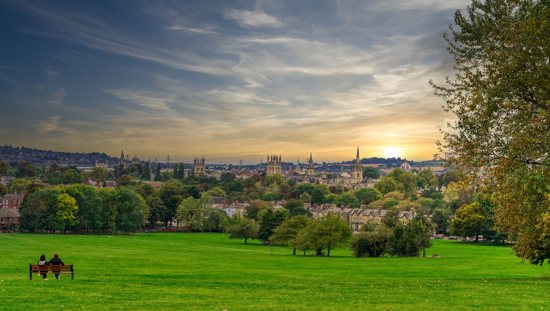
The name “Oxford” conjures up images of elite education taking place against the backdrop of ancient spires and an Earl Grey English sky. It’s the place, after all, that has produced Catholic geniuses like J.R.R. Tolkien and St. John Henry Newman.
But present-day Oxford isn’t only an old, world-class university; it’s also a bustling, English city of over 150,000 people.
In fact, the epicenter of the university is something of a tourist trap, like Disney World for nerds. Main Oxford arteries, like High Street, are often swarmed with tourists hustling about for high tea and Harry Potter-related sights.
It makes one wonder how Oxford students get any, you know, actual studying done.
The secret? The colleges.
The University of Oxford, as you may know, is made up of over 30 residential colleges — and each of them is like a little world unto its own.
The colleges are largely walled off, existing behind a frontward facing façade. Peeking through the entrance gates of colleges like Trinity, Merton and St. Edmund, one can observe courtyards and quads that are the epitome of tranquility and retreat. In a possible bit of Hogwarts-esque magic, it’s often surprising to see just how much space and greenery can be tucked behind what appears to be just a building from the outside.
Tourists may be allowed to throng the streets outside, but, with a few exceptions, the colleges themselves are preserved as sanctuaries of quiet and contemplation. In fact, in some stretches of Oxford, like Queen’s Passage, a quiet, narrow lane that zigzags along the back walls of several Oxford colleges, one can begin to hear oneself think in a way that is difficult amidst the hustle and bustle of the main streets.
In this way, the colleges of Oxford are like an architectural model of the interior life each of us is called to cultivate.
The colleges are like that “inner room” where Christ instructs us to go and pray. They are oases of transcendence, where the noise and anxieties of the world aren’t ignored or escaped from, but are left behind for a bit in order to view them with the proper perspective. To borrow a phrase of the German Catholic philosopher, Josef Pieper, within the walls of the college its inhabitants can “pierce the dome of the workaday world.”
This is especially evident in a place like the cloister of Magdalen (pronounced “Mawdlin”) College, the famous one-time residence of the Christian author, C.S. Lewis. The inner quad is surrounded on all four sides by the arched loggia and heightened structures of the college. It feels as if, in that cloister, one has a direct channel to the blue sky and heavenly realm above — which is all the more astounding considering that on the other side of the walls is one of the busier thoroughfares in Oxford.
And this is what our interior life should afford us: a direct connection with God that can be maintained even amid busyness and drama.
But there are ways to mistake what the detachedness of Oxford colleges, and thus of interior life, is about.
Recently, a tour group was observed exiting Balliol College onto busy Broad Street.
“And now back to reality,” said the tour guide. “Isn’t it horrible?”
The line was a quip, but it’s still worth interrogating. The interior life (nor a college education) isn’t an escape from reality. It’s the place we mentally go to focus on God alone. Not because God isn’t real, but precisely because he’s the realest thing there is. Spending time in our “inner room” with God then allows us to live the rest of life in a more real and authentic way. To see everything in light of him.
Very few of us will ever be admitted to Oxford. But each of us is called to cultivate our interior lives, so that we too may “pierce the dome of the workaday world.”
It might start by establishing our own inner courtyard of prayer — lectio divina with Scripture, adoring the Blessed Sacrament, or simple silent contemplation — and putting up “walls” to ensure its integrity. Getting rid of the smartphone, going to a designated place (even at home) and setting a specific time to pray are good ways to give our interior life a chance to grow.
Doing so might not earn us an Oxford diploma. But it will help us receive something infinitely more valuable: a deeper connection with God, the source of all wisdom, and the peace that surpasses all understanding.
Liedl, a Twin Cities resident, is a senior editor of The National Catholic Register and a graduate student in theology at The St. Paul Seminary School of Divinity in St. Paul.




